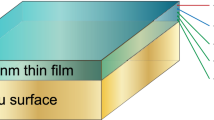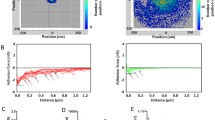Abstract
Two strains of the saprophytic Leptospira biflexa serovar patoc display reversible and irreversible adhesion at a solid-liquid interface. Both forms of adhesion are enhanced in the presence of 20 μM carbonyl cyanide metachlorophenyl hydrazone (CCCP), an uncoupler which inhibits motility of the bacteria. Microscopic observations also indicated that motility may have a role in adhesion as only actively motile organisms were seen to detach from the substratum. A dynamic model is proposed for adhesion of these organisms at a solid-liquid interface. It is suggested that the level of reversible adhesion is determined by the comparative rates of attachment (ON phase) and detachment (OFF phase). As reversible adhesion is mediated by weak forces of attraction, bacterial motility or gentle washing could promote the OFF phase. When motility is inhibited, the OFF phase is reduced and the ON phase continues (as motility is not required for the ON phase) causing the level of reversible adhesion to increase. Since reversible adhesion is a prerequisite for irreversible adhesion, then increased reversible adhesion leads directly to increased irreversible adhesion. Reversible adhesion appears to be mediated by the weak attractive forces of the “secondary minimum” whereas the mechanism facilitating irreversible adhesion of leptospires is not known.
Similar content being viewed by others
Abbreviations
- CCCP:
-
carbonyl cyanide meta-chlorophenyl hydrazone
References
Berg HC, Bromley DB, Charon NW (1978) Leptospiral motility. In: Stanier RY, Rogers HJ, Ward JB (eds) 28. Symposium of the Society for General Microbiology. London: Cambridge University Press, pp 285–294
Cox PJ, Twigg GI (1974) Leptospiral motility. Nature (London) 250:260–261
Derjaguin BV, Landau L (1941) Theory of the stability of strongly charged lyophobic sols and of adhesion of strongly charged particles in solutions of electrolytes. Arta Physicochim USSR 14:633–662
Fletcher M (1976) The effects of proteins on bacterial attachment to polystyrene. J Gen Microbiol 94:400–404
Harold FM (1977) Ion currents and physiological factors in microorganisms. Ann Rev Microbiol 31:181–203
Humphrey BA, Dickson MR, Marshall KC (1980) Physicochemical and in situ observations on the adhesion of gliding bacteria at surfaces. Arch Microbiol 120:169–175
Johnson RC, Harris VG (1967) Differentiation of pathogenic and saprophytic leptospires. I. Growth at low temperatures. J Bacteriol 94:27–31
Jones GW, Richardson LA, Uhlman DL (1981) The invasion of HeLa cells by Salmonella typhimurium: Reversible and irreversible bacterial attachment and the role of bacterial motility. J Gen Microbiol 127:351–360
Kefford B, Kjelleberg S, Marshall KC (1982) Bacterial scavenging: utilization of fatty acids localized at a solid-liquid interface. Arch Microbiol 133:257–260
Livermore BP and Johnson RC (1974) Lipids of the Spirochaetales: comparison of the lipids of several members of the genera Spirochaeta, Treponema and Leptospira. J Bacteriol 120:1268–1273
Marshall KC, Stout R, Mitchell R (1971) Mechanism of the initial events in the sorption of marine bacteria to surfaces. J Gen Microbiol 68:337–348
Uhlman DL, Jones GW (1982) Chemotaxis as a factor in interactions between HeLa cells and Salmonella typhimurium. J Gen Microbiol 128:415–418
Verwey EJW, Overbeck JThG (1948) Theory of the stability of lyophobic colloids. Elsevier, Amsterdam
Author information
Authors and Affiliations
Rights and permissions
About this article
Cite this article
Kefford, B., Marshall, K.C. Adhesion of Leptospira at a solid-liquid interface: a model. Arch. Microbiol. 138, 84–88 (1984). https://doi.org/10.1007/BF00425413
Received:
Accepted:
Issue Date:
DOI: https://doi.org/10.1007/BF00425413




